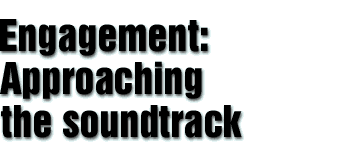|
 |
||
|
Larry Sider, editor, sound designer and curator of the School of Sound, explores ways of mastering the neglected dimension of filmmaking |
For whatever reasons, sound presents filmmakers with problems. Directors can develop multi-dimensional characters, structure plot lines over 90 minutes and interweave infinite sub-texts through a narrative, but they approach the soundtrack with an apprehension that freezes their imaginations. More often than not this stems from not understanding what the soundtrack is meant to do, its relationship to the picture, or its effect on the audience. And this predicament is made worse by relegating any thought of a film’s soundtrack to the far end of post-production when a film’s structure is set and the director is accustomed to what the film is saying.
Far too often, the director or producer expresses their desire for "good sound" merely hoping for intelligible dialogue and a memorable musical score. The soundtrack’s potential, however, is far greater. Yet it takes more than big budgets or sophisticated equipment to create an effective soundtrack.
There are no set rules for creating sound for images though, inevitably, that is what filmmakers are looking for. "Never leave complete silence." "Music, effects and dialogue should not interfere with one another. Use different frequency ranges for each." "Make all dialogue clear and intelligible," etc., etc. The only really useful rules that I can offer are Robert Bresson’s aphorisms: "What is for the eye must not duplicate what is for the ear." and "Image and sound must not support each other, but must work each in turn through a sort of relay." Guidelines really. And Bresson often ignores his own advice.
Why do we have sound on a film? Why do we treat music as a obligatory part of any soundtrack? Why don’t producers and directors consider the soundtrack until the end of post-production leaving its creation, for the most part, to people who have had no contact with the film to that point? Why don’t sound designers (and directors) have a wider range of influences affecting their tracks (as do cinematographers, art directors or costume designers)? The answers to these questions may explain why soundtracks tend to be mundane and unadventurous.
Discussions about sound production quickly turn to technique and technology which can be two of the greatest obstacles in creating an effective soundtrack, especially for low-budget films. A disk-based sound editing system (Audiovision, Audiofile, Soundscape, etc.) silently challenges the sound designer to use its powerful computer to the maximum. The result can be fascinating but often leans toward endless layers of atmos and effects, building up a wall of sound that pushes the audience away from the screen. In low budget films, in particular, the director has to be sensitive to well produced, technically perfect sound or music overwhelming the picture. So, once we know how to produce any sound we choose, the question turns to which sound should be used and why?
More often than not, technology is used to add layer upon layer to over-produced tracks than to utilise the technology to create stimulating, engaging, creative soundtracks...
Larry Sider
Quotes are from:
Sound Design: The Dancing Shadow by Walter Murch, Projections 4 (Faber and Faber, London, 1995)
Notes on the Cinematographer (Quartet Encounters, London, 1975) by Robert Bresson
The Shifting Point (Methuen, London, 1987) by Peter Brook
Full article published in Filmwaves - Issue 5, Summer 1998. Subscribe now!
